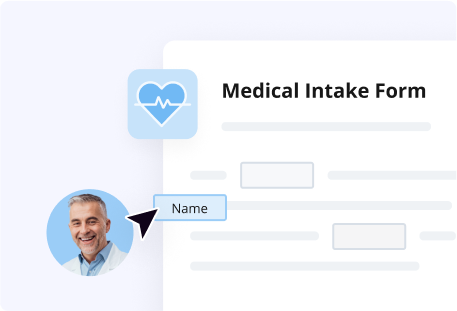Type any topic that interests you
Unlock the ins and outs of automating patient registration flow chart for a medical office with course

About this course for patient registration process flowchart
You’ll learn to design a streamlined and automated patient admission process utilizing airSlate. This skill will enable you to increase the productivity and precision of your patient intake flow, ultimately saving time and removing errors.
What’s included in the course:
- Classes highlighting all subtleties of streamlining patient registration Unlock the ins and outs of automating patient registration flow chart for a medical office with course for a medical office with airSlate.
- Quiz keeping your learning momentum going.
- A badge demonstrating your progress and results in course by airSlate Academy.
What will you learn?
- How to create patient registration Unlock the ins and outs of automating patient registration flow chart for a medical office with course Flow with dynamic fillable form(s).
- How to set up a conditional order of steps in your flow for a medical office .
- How to automate information routing between external programs and systems and your form.
- How to get information from patient intake processes with airSlate course.
Who is this course for?
- Medical employees interacting with patients and dealing with a medical office regularly.
- Administration and support managers involved in handling patient registration Unlock the ins and outs of automating patient registration flow chart for a medical office with course.
- IT managers maintaining the technology system of healthcare organizations.
More courses you might like
What our students say
Start learning today
Sign now for free
Questions & answers
Healthcare workers deal with many problems when dealing with paper-centered patient registration or flow chart created by unreliable tools. These include Illegible handwriting, error-prone information processing, ineffective wet-signature collection, and compliance issues. Dodge these inefficiencies by engaging an automated patient registration flow chart that you can create and configure quickly with airSlate.
airSlate Academy is your go-to option for learning how to take your medical care practice to a whole new level and streamlining your important transactions, including patient registration flow chart flow processing. The course is free and self-paced, so you can take it anytime and on your own terms. Don’t hesitate and sign up for our new course today!
You can utilize different tools and resources to create your patient registration flow chart, such as online templates, healthcare software, and document creation programs. This normally entails identifying essential information that needs to be gathered from a patient, designing a form, and testing it to ensure it is user-friendly and easy to complete. A wide variety of course options online will help you enhance this process and make it as time and effort-saving as possible.
The perks of automating the patient registration flow chart for a medical office include improved productivity, document handling precision, and budget savings. By automating patient intake processes, healthcare providers can accomplish a variety of advantages, including reducing wait times, eliminating the necessity for manual data entry, reducing costs related to printing and shipping, and improving file security. Moreover, it considerably improves patient satisfaction by providing a smooth and efficient intake flow that reduces waiting times, streamlines information collection, and reduces potential mistakes and inaccuracies.
The objective of patient registration flow chart is to request and handle essential information, generally at the initial point of interaction with a patient. This information generally consists of demographic data, medical history, insurance details, and other information that will allow healthcare workers make certain that the patients get exceptional care. By collecting these details, medical care companies can improve the care process and ensure patients receive the best possible treatment.
The patient registration is a essential component of patient registration. It allows medical care providers to collect crucial patient data through flow chart, like personal and contact details, health history, appointment scheduling, and insurance information. Patient registration significantly affects your clients’ overall experience by establishing a favorable first impression, decreasing waiting times, and offering medical personnel with exact information for treatment and insurance claims.











